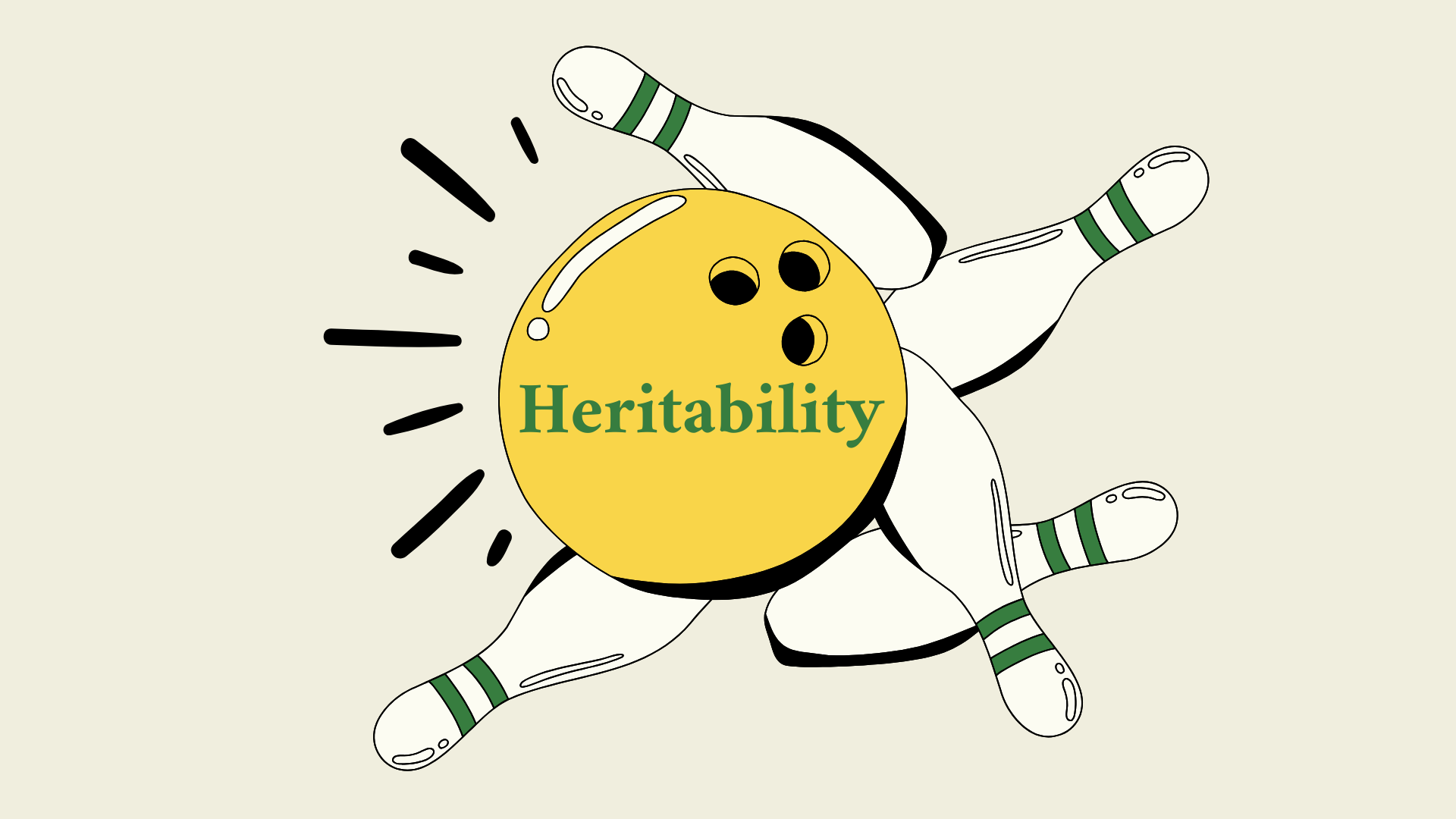TOPICS
- Practical Benefits of using Heritability Scores (infographics)
- Five Common Misconceptions About Heritability in Breeding (infographics)
Practical Benefits of using Heritability Scores
Heritability scores offer significant benefits in plant breeding, helping breeders make informed decisions, yet breeding misconceptions often lead to missed opportunities and errors. This post explores the true value of heritability, clears up common misunderstandings, and provides practical insights to refine your selection strategies and maximize genetic progress.
The reality is that breeders collect phenotypic data and use them to decide on which plants they will select. Their goal is to achieve high genetic gains in each selection cycle. But, they sometimes observe that the genetic gain, supposedly made for certain traits in one cycle, is lost in the next one.
This happens because phenotypes are influenced not only by genetics but also by environmental factors such as weather, soil conditions, and pathogens. As environmental noise increases, phenotypes become less informative of the underlying genotypes, leading to poor selection decisions.
What is heritability?
To address this, breeders can measure the proportion of phenotypic variation due to genetic differences within a population. This is expressed as heritability, a ratio ranging from 0 to 1, where higher values indicate greater genetic influence on a trait.
Heritability, in everyday language, describes the similarity between parents and offspring, but in plant breeding, it is a biometrical tool with practical applications. When a trait has high heritability, breeders can more confidently select plants with the desirable gene combinations, increasing the probability that these genotypes will be passed on to the next generation.
In essence, understanding heritability helps breeders to predict the success of their selection strategies.
Heritability scores also guide other key decisions, such as prioritizing traits based on genetic potential, optimizing experimental designs to minimize environmental noise, efficiently allocating resources, and refining phenotyping methods for greater accuracy.
Now, let’s delve deeper into the five benefits of using heritability in plant breeding.
1. Predicting Genetic Gain
Using heritability scores, breeders can predict the genetic gain and adapt their selection strategy on different scenarios. In case of traits with high heritability, breeders can base their selection on the performance of individual plants. However, for traits with lower heritability, family or pedigree selection may be more successful. In these cases, breeders select individuals based on the average performance of their family or kin group, which helps account for environmental variability.
Traits with high heritability also permit the breeders selecting few top-performing individuals in every cycle, leading to rapid accumulation of genetic gains. In the opposite situation, breeders must lower their intensity selection and increase the number of the selected plants, trying to compensate for the impact of the external factors on the phenotype.
2. Balancing Traits
Breeders often need to select for multiple traits, but with limited resources, they must prioritize which traits to improve. Heritability helps them identify which traits are more strongly influenced by genetics and therefore more likely to respond to selection. For traits with high heritability, breeders can focus on achieving rapid improvement in early generations, then shift their attention to traits with lower heritability in later generations.
3. Resource Allocation
Traits with varying heritability require different levels of investment in labor, space, and infrastructure. For traits with low heritability, breeders need to increase the number of individuals, allowing for larger family sizes and more experimental replications, while also intensifying efforts to control environmental factors. In contrast, traits with high heritability enable breeders to invest less in environmental management and population size, yet still achieve significant genetic gains. Therefore, understanding heritability allows breeders to allocate their resources more efficiently.
4. Experimetanl design
Traits with different heritability levels may require experimental designs of varying complexity. For traits with low heritability, breeders must structure trials to minimize environmental noise and control genotype-by-environment (GxE) interactions.
These designs often include multiple genotype replications, random placement of genotypes, the use of experimental blocks, and trials across multiple locations. Such approaches lead to more accurate predictions of genetic gain and make plant breeding programs more effective
5. Improving Phenotyping Protocols
For complex traits, such as drought tolerance or disease resistance, which are influenced by multiple genes and environmental factors, heritability helps breeders assess the genetic potential for improvement. Even if these traits have moderate heritability, breeders can still develop effective selection strategies by improving the precision of the phenotyping protocols.
Rather than relying solely on traditional phenotyping, they can integrate advanced approaches into their selection process, such as using drones or image analysis for data collection, employing marker-assisted selection, and conducting pathogen testing in the laboratory.

Check out the infographic below to see the top five benefits of using heritability in plant breeding

Five Common Misconceptions About Heritability in Breeding
We have seen previously that breeders can benefit from calculating and using heritability values when deciding their breeding strategy. However, they misunderstand the concept of heritabilityin some cases, leading to inefficient selection strategies. Here, we debunk five common misconceptions about heritability and its application in breeding programs.
1. Heritability is a Fixed Value
Heritability is not an absolute value; it varies depending on the population, environment, and management conditions. A trait with high heritability in one environment may show lower heritability in another due to different environmental influences or less efficient phenotyping protocols.
For example, if breeders evaluate resistance to a disease caused by natural conditions, they run the risk of characterising sensitive genotypes as resistant if the infection rate is low. But if they inoculate the plants artificially with the pathogen of interest, they ensure higher infection rates and less errors in classifying the plants as sensitive or resistant.
The heritability of a trait can change depending on the environment, the population and the management conditions.
2. Low Heritability Means Selection is Useless
We often consider traits with low heritability difficult to improve, leading to disregard them in selection programs. But, as we mentioned before, heritability is not a static value; breeders can improve it by integrating different strategies in their programmes, like using standardized phenotyping protocols, experimental designs to reduce the effect of the environment and larger population sizes.
A good example of improving heritability is to use molecular markers for selecting the plants with the desirable genotype. Marker-assisted selection (MAS) targets specific genomic regions associated with the desired characteristics. So, it turns out to be more reliable than standardized phenotyping protocols because changes in the environmental do not affect the gnetic markers, ensuring consistent and accurate selection across different conditions.
3. High Heritability Means a Trait is Easy to Improve
Many breeders assume that if a trait has high heritability, improving it will be an easy and rapid task. However, heritability only reflects the proportion of trait variation due to genetic factors in a specific population and environment. If selection intensity is low or genetic variation is limited, progress may still be slow. High heritability does not replace the need for strategic selection and population management.
Consider plant height in wheat, which often has high heritability (e.g., 80%). A breeder aiming to develop shorter wheat varieties for lodging resistance might assume that selection will quickly reduce plant height. However, despite the high heritability, genetic progress could be slow if:
- Limited Genetic Variation: If the breeding population already consists of mostly short plants, there may not be enough genetic variation to make further improvements.
- Low Selection Intensity: If breeders apply only mild selection pressure (e.g., keeping many taller plants in the breeding pool), genetic gain per cycle will be minimal.
- Environmental Factors: Even with high heritability, soil fertility or water availability can still influence plant height, requiring multi-environment trials to ensure stable selection.
This example highlights why high heritability alone does not guarantee rapid progress—effective selection strategies and sufficient genetic diversity are essential for achieving breeding goals.
4. Heritability Applies to Individuals
Heritability is a population-level statistic and does not predict the genetic potential of a single individual. It describes the proportion of observed variation that is genetic within a given population, not the likelihood that an individual will pass on a trait. Breeders should interpret heritability in the context of population-wide selection rather than as a measure of individual performance.
Consider fruit weight in tomato, which often has moderate to high heritability (e.g., 60–70%). A breeder might assume that selecting a single plant with large fruits will ensure that its offspring also produce large fruits. However, this is a misunderstanding of heritability:
- Population-Level Measure: A heritability of 70% means that 70% of the variation in fruit weight within the tested population is due to genetic factors, not that a specific plant will reliably pass on its large fruit size to its progeny.
- Influence of Other Factors: Environmental conditions (soil nutrients, water availability, temperature) and random genetic recombination also affect fruit size, meaning offspring from the selected plant may not consistently produce large fruits.
- Breeding Program Perspective: Effective selection should be based on replicated trials, statistical analysis (e.g., BLUP), and multi-generation selection, rather than choosing a single standout plant.
This example highlights why breeders should be interprete heritability at the population level, guiding selection strategies rather than predicting individual plant performance.
5. A high heritability implies a major-effect QTL
A common misconception is that a high heritability value indicates the presence of a major-effect QTL (quantitative trait locus) controlling the trait. However, heritability simply quantifies how much of the observed variation in a trait is due to genetic factors within a specific population and environment—it does not reveal the number or effect size of the underlying genes. A trait controlled by a single major QTL can have low heritability if there is little variation in the population being studied.
For example, eye color in a population where most individuals have the same color will show low heritability, despite being largely determined by a few genes. Conversely, highly polygenic traits, such as grain yield in wheat, can exhibit high heritability if the experiment is well-designed, with proper replication and minimal environmental noise. However, the same trait can show low heritability if poor agronomic management introduces excessive environmental variability, masking genetic differences. This highlights the importance of experimental design and population structure in interpreting heritability rather than assuming it reflects the genetic architecture of a trait.

Check out the infographic below to see the top five misconceptions about heritability in plant breeding

Final Thoughts
Understanding heritability correctly is crucial for maximizing genetic gains in breeding programs. By avoiding these misconceptions, breeders can make more informed decisions, optimize selection strategies, and improve the efficiency of their breeding efforts.
At AgroSynapsis, we help breeders apply statistical tools and molecular techniques to enhance trait selection. If you’re interested in optimizing your breeding program, contact us to learn more about our heritability analysis services!


